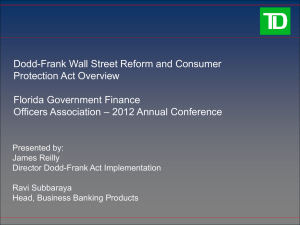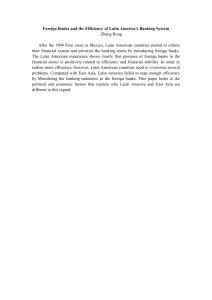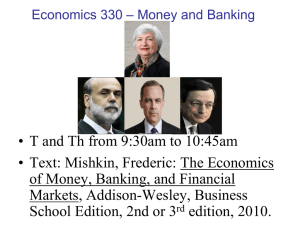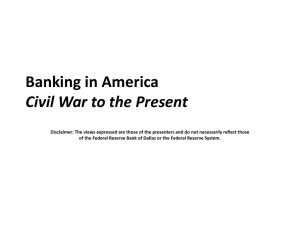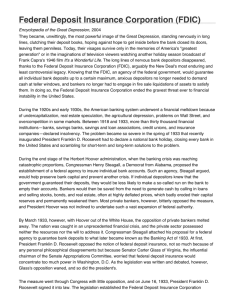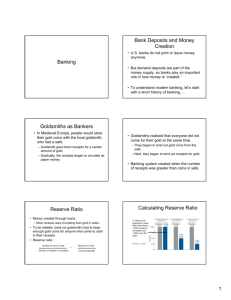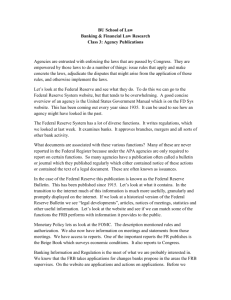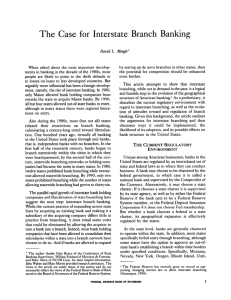Answers to Handout for March 25, 2003
advertisement
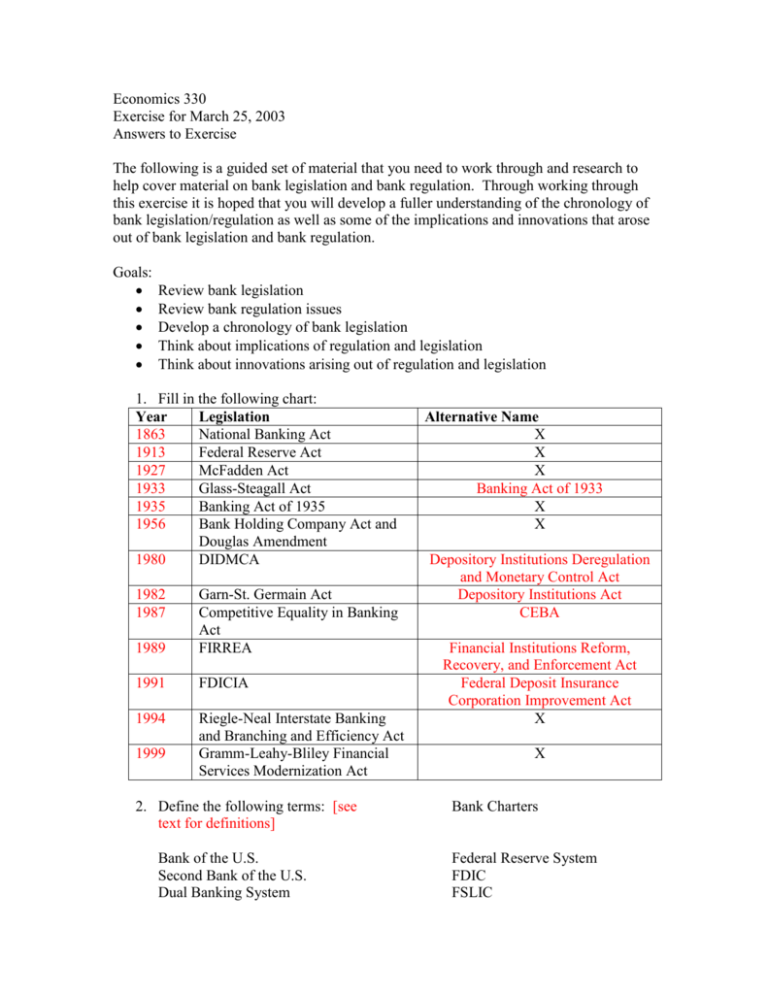
Economics 330 Exercise for March 25, 2003 Answers to Exercise The following is a guided set of material that you need to work through and research to help cover material on bank legislation and bank regulation. Through working through this exercise it is hoped that you will develop a fuller understanding of the chronology of bank legislation/regulation as well as some of the implications and innovations that arose out of bank legislation and bank regulation. Goals: Review bank legislation Review bank regulation issues Develop a chronology of bank legislation Think about implications of regulation and legislation Think about innovations arising out of regulation and legislation 1. Fill in the following chart: Year Legislation 1863 National Banking Act 1913 Federal Reserve Act 1927 McFadden Act 1933 Glass-Steagall Act 1935 Banking Act of 1935 1956 Bank Holding Company Act and Douglas Amendment 1980 DIDMCA 1982 1987 1989 Garn-St. Germain Act Competitive Equality in Banking Act FIRREA 1991 FDICIA 1994 Riegle-Neal Interstate Banking and Branching and Efficiency Act Gramm-Leahy-Bliley Financial Services Modernization Act 1999 2. Define the following terms: [see text for definitions] Bank of the U.S. Second Bank of the U.S. Dual Banking System Alternative Name X X X Banking Act of 1933 X X Depository Institutions Deregulation and Monetary Control Act Depository Institutions Act CEBA Financial Institutions Reform, Recovery, and Enforcement Act Federal Deposit Insurance Corporation Improvement Act X X Bank Charters Federal Reserve System FDIC FSLIC Comptroller of the Currency CAMELS System Bank Holding Companies Nonbank Banking Forbearance Too big to fail Leverage Ratio Off-balance Sheet Activities Adverse Selection Moral Hazard Money Center Banks Return on Assets Return on Equity Equity Multiplier Compensating Balances Credit Rationing Financial Disintermediation Deposit Rate Ceilings NOW Account Sweep Account Superregional Banks Junk Bonds Securitization Commercial Paper Market Money Market Mutual Funds Disintermediation Regulation Q Lender of last resort Systemic risk Regulatory forbearance Call Reports 3. Fill in the following table. Institution Regulatory Agency with responsibility for regulation of institution National Banks State Banks that are members of the Federal Reserve System State Banks that are not members of the Federal Reserve System but carry FDIC insurance State Banks that are not members of the Federal Reserve System and that do not carry FDIC insurance Bank Holding Companies Office of the Comptroller of the Currency Federal Reserve Regulatory Agency that conducts on-site examinations (post FDICIA) FDIC FDIC FDIC and State Banking Authorities FDIC State Banking Authorities FDIC Federal Reserve FDIC 4. In this question you are asked to identify the financial innovation(s) that occurred as a result of a regulatory restriction and/or a change in the economic environment. For each of the following situations identify the financial innovation that occurred. a. Restrictions on interest being earned on deposits: NOW accounts, money market deposit accounts (MMDAs), Eurodollars, bank commercial paper, sweep accounts b. Avoidance of reserve requirements: MMDAs, Eurodollars, bank commercial paper c. Use of liabilities by banks to provide banks with reserves and liquidity: overnight loan markets (fed funds market), negotiable CDs d. Responding to the volatility of interest rates: adjustable rate mortgages e. Improvement in computer and telecommunications technology: bank credit and debit cards, ATM, home banking f. Restrictions with regard to branching: bank holding companies, nonbank banks, ATM g. Loosening of restrictions with regard to interstate branching: consolidation of banks, superregional banks 5. Discuss four different financial innovations that have contributed to the decline of traditional banking activities. How have they contributed to this decline? [see text for details] The four different financial innovations that have contributed to the decline of traditional banking activities are money market mutual funds (MMMFs), junk bonds, commercial paper, and securitization. 6. A. What does the term “loophole mining” mean? [see text for definition] B. Identify the three broad sets of regulations that have particularly led to loophole mining on the part of the banking industry. Three broad sets of regulations that have particularly led to loophole mining include 1) reserve requirements; 2) interest rate restrictions; and 3) restrictions on branching. C. Discuss four examples of loophole mining. Examples could include Eurodollars, bank commercial paper, NOW accounts, sweep accounts, bank holding companies, nonbank banks, automated teller machines (ATMs). 7. Here are eight possible matches for the following phrases: a. Competitive Equality Bank Act of 1987 b. McFadden Act c. Glass-Steagall Act of 1933 d. Riegle-Neal Interstate Banking and Branching Efficiency Act e. Office of the Comptroller of the Currency f. Junk Bonds g. Gramm-Leach-Bliley Financial Services Modernization Act of 1999 h. Commercial Paper Identify out of the above list the best match for the following: 1. 2. 3. 4. Short-term debt security __H____ Moratorium on new nonbank banks __A__ Fallen angels __F___ Expansion of regional compacts to the entire nation __D__ 5. Prohibition of interstate banking ___B__ 6. Legislative Act that encouraged bank consolidation ___D__ 7. Prohibition for banks underwriting corporate securities __C__ 8. Regulator for bank subsidiaries that underwrite securities __E__ 9. Separation of banking and other financial services industries __C___ 10. Purchase of banks by securities firms and insurance companies allowed __G___ 11. Prohibition of banks engaging in brokerage services __C___ 8. What is the payoff method? What is the purchase and assumption method? Compare and contrast these two methods the FDIC uses to handle a failed bank. [see text for descriptions and comparisons: think particularly about which method benefits large depositors; which method has the greatest potential for creating a moral hazard problem for taxpayers; does the method used affect monitoring by depositors] 9. Explain why the too-big-to-fail policy creates a moral hazard problem. [see text for description of this policy and interpretation of the potential for moral hazard problems arising out of the adoption of such a policy]

